The 1.5 mile Lacey V. Murrow Bridge was the largest floating structure in the world and the first to be built of reinforced concrete when completed in 1940. The bridge consisted of typically 300-foot long pontoons floated to site and rigidly connected to form a continuous structure and incorporated a unique floating concrete draw-span to allow for passage of marine traffic. The original floating structure, constructed by Pontoon Bridge Builders, was accidentally sunk in 1990 during a major renovation effort and was replaced by 1993.
Bridge
This bridge is recognized as the first iron bridge in the world. This rural region of England was an important industrial area thanks to coal deposits near the surface. In 1776 the nearest bridge that enabled people and goods to pass over the River Severn was two miles away at Buildwas. There was a ferry crossing, but the trip was difficult and dangerous especially in winter. In 1776, an Act to build a bridge to remedy this situation received Royal Assent.
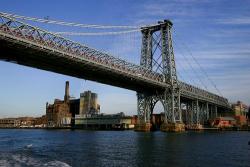
When opened in 1903, the 1,600 foot long main span of the Williamsburg Bridge was the world's longest suspension span, surpassing the nearby Brooklyn Bridge by only 4.5 feet. The Williamsburg Bridge remained the world's longest suspension bridge span for 21 years until the opening of the Bear Mountain Bridge in 1924. The Williamsburg Bridge has two unsuspended side spans of 596.5 feet, each supported from below by trussed towers, giving the bridge an overall length of 2,793 feet. The four main suspension cables are 18.75 inches in diameter and each composed of over 10,000 wires.
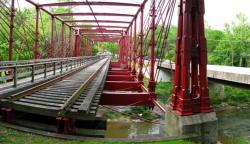
The design of the Bollman Truss Bridge-patented in 1852 and one of the first to use iron exclusively in all essential structural elements-was critical in the rapid expansion of American railroads in the 19th century. Replacing wooden bridges, which were cumbersome to build and vulnerable to decay, the Bollman Truss Bridge could be built relatively quickly and inexpensively, while providing the long-lasting qualities associated with metal. This allowed new rail lines to be built over long distances in a short period of time.
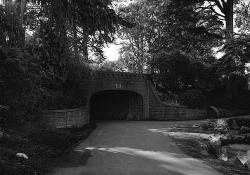
Alvord Lake Bridge, along with many of Ernest Ransome's reinforced concrete buildings, survived the 1906 San Francisco earthquake and several subsequent tremblers with no damage. Built in 1889 by Ernest L Ransome of New York, this reinforced concrete arch bridge in San Francisco's Golden Gate Park is believed to be the oldest concrete bridge in the United States that used steel reinforcing bars to improve the behavior of the concrete. The reinforcement consists of a series of square cold-twisted steel reinforcing bars, an invention of Ransome.
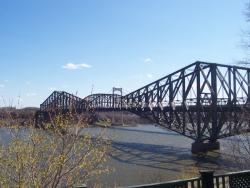
The bridge is immense, not only in length and weight but in width. At 67 feet wide, it can accommodate two sets of railway tracks, two sets of streetcar tracks and two roadways.
It took three tries and cost 89 lives, but the city of Quebec was determined to compete with provincial rival Montreal for commercial rail traffic in the late 19th century. The solution was a rail bridge across the St. Lawrence River requiring a single cantilever span 1,800 feet long - the longest ever attempted.
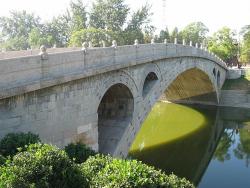
Ancient Chinese literature refers to the Zhaozhou Bridge as a "crescent moon rising from the clouds" or a "rainbow in the sky." Throughout its history, it has been known as the Anchi or Anji Bridge (literally "safe crossing"), the Dashi Bridge ("big stone"), and the Dashiqiao ("great stone") Bridge.
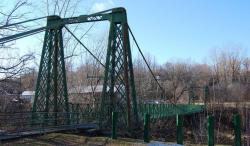
A 214-foot single-span covered wooden bridge, built above the cribs of stone in the AuSable River that served to break log jams and ice floes, collapsed during the winter of 1875 under the weight of a three-foot snowfall and high winds. The "Upper Bridge" (pictured) was built in its place.
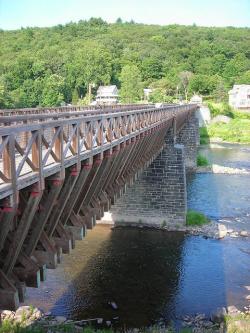
The Delaware Aqueduct provided an important transportation link between the Pennsylvania's coalmines and New York's booming industrial marketplace. It is the earliest surviving work of John A. Roebling, who designed the Brooklyn Bridge 30 years later. The cable anchorage system first used on this project was also used on the Brooklyn Bridge. The aqueduct is patterned after Roebling's design of the Pennsylvania Canal over the Allegheny River, and is the oldest metal strand cable suspension bridge still standing in the U.S.
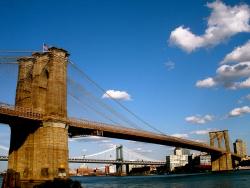
On May 24, 1883, with schools and businesses closed for the occasion, New York celebrated the opening of the Brooklyn Bridge. Also known as the Great East River Bridge, it was built over 14 years in the face of enormous difficulties. Deaths, fire in the Brooklyn caisson, and a scandal over inferior materials all added to the turmoil. The bridge is one of the most well-recognized symbols of American engineering, and remains the unofficial Eighth Wonder of the World.
Innovations
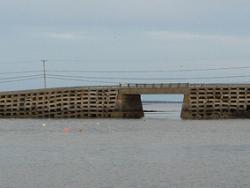
Hardy fishermen and their families have long inhabited Bailey Island, which was settled in the 1720s. Ordinarily, they did not mind crossing to the mainland in their fishing boats. But before the Bailey Island Bridge was built, during certain seasons of the year when violent storms battered the…
Read More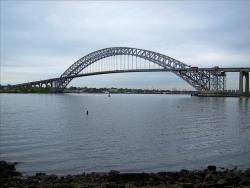
The longest steel-arch bridge in the world for 46 years, the Bayonne Bridge continues to be celebrated today as a major aesthetic and technical achievement. The 1,675-foot bridge replaced a ferry service which until then was the only means of crossing from the Bayonne peninsula to Staten Island…
Read More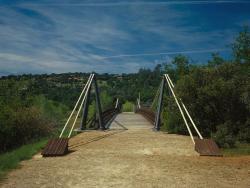
Soon after gold was discovered at Sutter's Mill near Sacramento in 1848, General John Bidwell found gold near the Middle Fork of the Feather River. His discovery brought hordes of miners to the scene and Bidwell Bar was born. The Bidwell Bar Suspension Bridge over the Feather River was one of…
Read More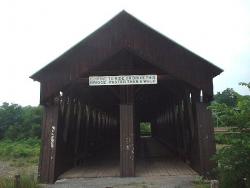
Nicholas Montgomery Powers built the bridge. It was first constructed behind the village, then taken apart and reassembled over the stream. Some residents questioned the idea of re-constructing it, but Powers was so confident of the bridge's durability that he sat on the roof when the final…
Read More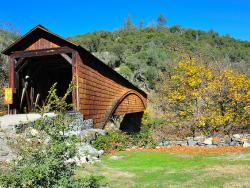
A product of the Northern California Gold Rush, the Bridgeport Covered Bridge is believed to be the longest, single-span, wooden covered bridge in the United States. Crossing the south fork of the Yuba River at a span of 233 feet, the bridge was built by the Virginia City Turnpike Company as…
Read More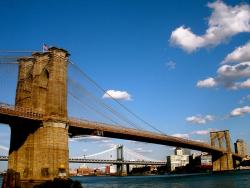
On May 24, 1883, with schools and businesses closed for the occasion, New York celebrated the opening of the Brooklyn Bridge. Also known as the Great East River Bridge, it was built over 14 years in the face of enormous difficulties. Deaths, fire in the Brooklyn caisson, and a scandal over…
Read More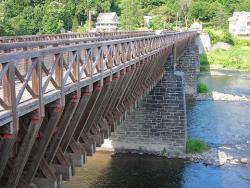
The Delaware Aqueduct provided an important transportation link between the Pennsylvania's coalmines and New York's booming industrial marketplace. It is the earliest surviving work of John A. Roebling, who designed the Brooklyn Bridge 30 years later. The cable anchorage system first used…
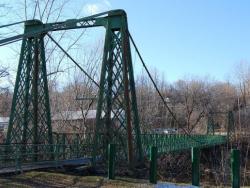
A 214-foot single-span covered wooden bridge, built above the cribs of stone in the AuSable River that served to break log jams and ice floes, collapsed during the winter of 1875 under the weight of a three-foot snowfall and high winds. The "Upper Bridge" (pictured) was built in its place.…
Read More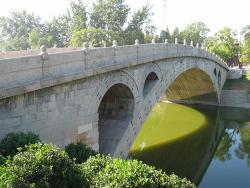
Ancient Chinese literature refers to the Zhaozhou Bridge as a "crescent moon rising from the clouds" or a "rainbow in the sky." Throughout its history, it has been known as the Anchi or Anji Bridge (literally "safe crossing"), the Dashi Bridge ("big stone"), and the Dashiqiao ("great stone")…
Read More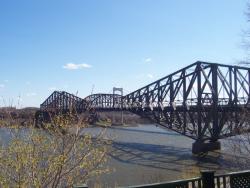
The bridge is immense, not only in length and weight but in width. At 67 feet wide, it can accommodate two sets of railway tracks, two sets of streetcar tracks and two roadways.
It took three tries and cost 89 lives, but the city of Quebec was determined to compete with provincial rival…
Read More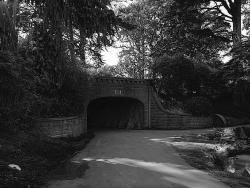
Alvord Lake Bridge, along with many of Ernest Ransome's reinforced concrete buildings, survived the 1906 San Francisco earthquake and several subsequent tremblers with no damage. Built in 1889 by Ernest L Ransome of New York, this reinforced concrete arch bridge in San Francisco's Golden Gate…
Read More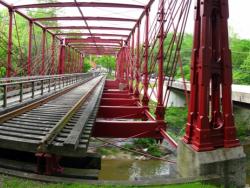
The design of the Bollman Truss Bridge-patented in 1852 and one of the first to use iron exclusively in all essential structural elements-was critical in the rapid expansion of American railroads in the 19th century. Replacing wooden bridges, which were cumbersome to build and vulnerable to…
Read More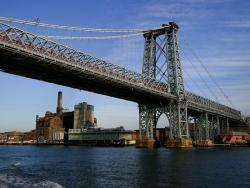
When opened in 1903, the 1,600 foot long main span of the Williamsburg Bridge was the world's longest suspension span, surpassing the nearby Brooklyn Bridge by only 4.5 feet. The Williamsburg Bridge remained the world's longest suspension bridge span for 21 years until the opening of the Bear…
Read MoreThis bridge is recognized as the first iron bridge in the world. This rural region of England was an important industrial area thanks to coal deposits near the surface. In 1776 the nearest bridge that enabled people and goods to pass over the River Severn was two miles away at Buildwas. There…
Read MoreThe 1.5 mile Lacey V. Murrow Bridge was the largest floating structure in the world and the first to be built of reinforced concrete when completed in 1940. The bridge consisted of typically 300-foot long pontoons floated to site and rigidly connected to form a continuous structure and…
Read More

